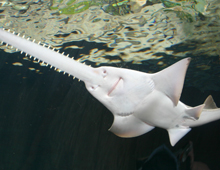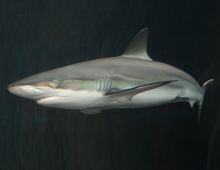Mundo Maya

Queen angelfish, Holocanthus ciliaris
One of the first salt water tropical fishes to be kept in aquariums, this beautiful fish was exhibited live by P.T. Barnum (of circus fame) at his American Museum in New York in the 1860s and has remained a popular species in public aquariums ever since. In the 1930s, the New York Aquarium sent specimens all the way by ship to East London, in South Africa, in exchange for turkeyfish. In parts of its extensive range in the Caribbean, the Gulf of Mexico, and the Tropical Western Atlantic, it is a food fish. Its wild diet is almost exclusively sponges.
LEARN MORE
Rooster hogfish, Lachnolaimus maximus
Though dwarfed by its six-foot long, 300-pound Pacific relative, the Napoleon wrasse, at nearly three feet, and over 20 pounds, the hogfish is the largest wrasse in the Caribbean. Like the Napoleon Wrasse, it is threatened by overfishing. Considered delicious, it is a prime target for spear fisherman. It is classified as Vulnerable to Extinction over its range from Bermuda to Brazil. It remains abundant in some habitats, such as the Florida Keys. Its powerful jaws and teeth equip it to consume crabs, sea urchins and mollusks.
LEARN MORE
Goliath grouper, Epinephelus itajara
The Goliath grouper, also referred to as a Jewfish or Giant seabass, is found in the Western Atlantic Ocean, through the Gulf of Mexico and Caribbean Sea and into South America. It is also found off the west coast of Africa and from the Baja peninsula through Central America. It occurs in shallow, inshore waters as an adult and can be found as a juvenile in mangroves and brackish estuaries. It is territorial in nature and can be seen displaying an open mouth and quivering when approached by unwanted intruders. The Goliath grouper can also produce a rumbling sound by contracting the muscles of its airbladder. It is the largest of the Sea basses and can weigh more than 800 pounds. It is an important commercial species, especially in the sport fishing industry. It is protected by law in US waters, and fishing for this species is prohibited.
LEARN MORE
Spotted eagle ray, Aetobatus narinari
The Spotted eagle ray is named for the spots on the dorsal side of its body, and for the way that it appears to “fly” underwater. It is also known as a Duckbill ray because of the unique shape of its nose which is used to locate its prey in sandy sediments. Spotted eagle rays can be found in large schools in bays or coral reefs, but spend a great deal of time in open water. When being pursued by a potential predator, it can be seen leaping from the water. The Spotted eagle ray possesses a venomous spine at the base of its tail and can inflict a serious wound. It is protected by law in the State of Florida, but is not considered an important commercial fisheries species.
LEARN MORE
Bonnethead shark, Sphyrna tiburo
The Bonnethead shark is the smallest member of the Hammerhead family, reaching only about four feet in total length. It is found in tropical waters of the Atlantic coast from New England, through the Gulf of Mexico and well into South America. It is also found from the Baja peninsula through the west coast of Mexico and Central America. Bonnethead sharks usually occur in small schools of up to 15 individuals. When migrating, they can be found in schools of hundreds or thousands. Scientists believe that the Bonnethead shark contains a specialized type of cerebrospinal fluid that helps Bonnetheads communicate chemically when another Bonnethead is nearby. They are considered harmless to humans.
LEARN MORE
Freshwater Sawfish, Pristis microdon
The Freshwater sawfish, or Largetooth sawfish, is a unique cartilaginous fish that is a member of the order Rajiformes which includes stingrays and guitarfishes. It is named for the long rostrum that bears “teeth” on either side. The sawfish uses this rostrum to swipe at and stun schooling fish and other prey items such as benthic invertebrates. The Freshwater sawfish is found in shallow estuarine waters in Africa, Asia and Australia and can live in both fresh and saltwater. It closely resembles the small tooth sawfish Pristis pectinata which is found off the coast of the Yucatan Peninsula.
LEARN MORE
Brown shark, Carcharhinus plumbeus
The Brown shark, also known as the Sandbar shark is commonly found in public aquariums. The genus name Carcharhinus is derived from Greek words meaning “sharpen nose”. It is a coastal-pelagic shark that lives in temperate and tropical waters throughout the world. It is naturally a bottom-dwelling shark found in shallow coastal waters, and is known to be highly migratory. The Brown shark is an important species in commercial fisheries along the Eastern United States, and is the primary targeted species in this area. Because of its age at reproduction and the fact that it reproduces every other year producing a small number of young, the Brown shark is vulnerable to over-exploitation. Although rarely associated with attacks on humans, the size of the Brown shark makes it a potential threat.
LEARN MORE
Black hawk-eagle, Spizaetus tyrannus
The biodiversity of New World rain forests is demonstrated by the abundance of eagles that can be found in one place. This species (in addition to the Ornate hawk-eagle, the Guiana crested eagle, the Harpy Eagle and the Black-and-white Hawk-eagle) all range from Meso-America, through Amazonia and beyond in South America. All five are kept at the DWA, the only place to now do so. Also called the Tyrant hawk-eagle, this rarely-kept species has not yet bred in collections. Fertile eggs have been laid at the DWA.
LEARN MORE

